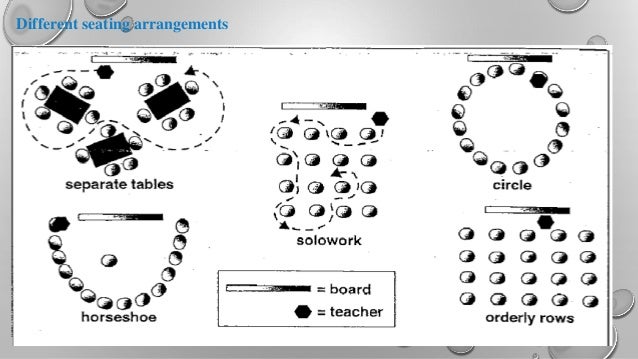The Importance of Seating Arrangements in the Classroom
 |
Several possibilities for seating arrangements in the classroom
As someone who is wanting to teach at the high school level one day, I think it is important to realize the implications on a learning environment that can be brought on by a good or bad seating arrangement. And as someone who was not in high school very long ago, I thought I would share some of my experiences regarding what works and what doesn't.
The Orderly Rows Arrangement: This is probably the most traditional seating arrangement that there ever was. This arrangement consists of perfect rows of desks all of which face the board. The attention is focused at the front of the classroom, the board, and the instructor. This arrangement is beneficial if the attention desire is to be at the front of the room constantly. There is little room for collaboration between students and the instructor is to always be the center of attention. If this arrangement is good for any subject, I think it would be math.
The Separate Tables Arrangement: The separate tables arrangement is mostly seen in elementary and middle schools. It works wonders for student collaboration and has the potential for students to grow socially by interacting with new peers. If the arrangement has drawbacks, it is that some students will inevitably have their backs to the front of the room. This makes it difficult for them to focus their attention on the front of the room. Students may have more trouble paying attention, as they may be in an interactive setting with their peers.
The Circle Arrangement: The circle arrangement works best when a class discussion is required. All students can see and hear each other. The teacher can sit among the students and hear all contributions. If I recall any drawback of the circle arrangement, it is that it can be a tad intimidating for students who are hesitant to speak up in front of their peers. With all eyes on the speaker, a sense of stage fright may induce a student to hold back his or her comments in discussion.
The Face to Face Arrangement: The face to face arrangement of desks is my favorite arrangement by far. I experienced it in a Senior year English class and thought that it worked out the best for me. For one, there are two groups of students sitting in a cluster of desks that face each other. This is ideal for assignments that require a debate format. Two opposing sides can sit across from each other, debate, and communicate face to face. Also, the instructor is able to be positioned in the middle of the two groups, to direct and support the students. This way, the teacher is not seen as the main authority in the class, but more of a guidance figure. Arranging the desks in this way allows for a significant space in the middle of the classroom. This is ideal for presentation giving and student performances. There is not an audience straight in front of you, so it is less intimidating. For projects that require collaboration, the arrangement gives way to pre-sectioned groups.
https://www.google.com/search?q=classroom+seating+arrangements&espv=2&biw=1600&bih=799&source=lnms&tbm=isch&sa=X&ved=0ahUKEwiS6a-NkfvKAhVCn4MKHQGeC50Q_AUIBigB#imgrc=9L_XZ17xiJj0sM%3A
https://www.google.com/search?q=classroom+seating+arrangements&espv=2&biw=1600&bih=799&source=lnms&tbm=isch&sa=X&ved=0ahUKEwiS6a-NkfvKAhVCn4MKHQGeC50Q_AUIBigB#imgrc=hFOZIAndoqm3BM%3A
https://www.google.com/search?q=classroom+seating+arrangements&espv=2&biw=1600&bih=799&source=lnms&tbm=isch&sa=X&ved=0ahUKEwiS6a-NkfvKAhVCn4MKHQGeC50Q_AUIBigB#imgrc=5a6lnT3BPMxAPM%3A
|